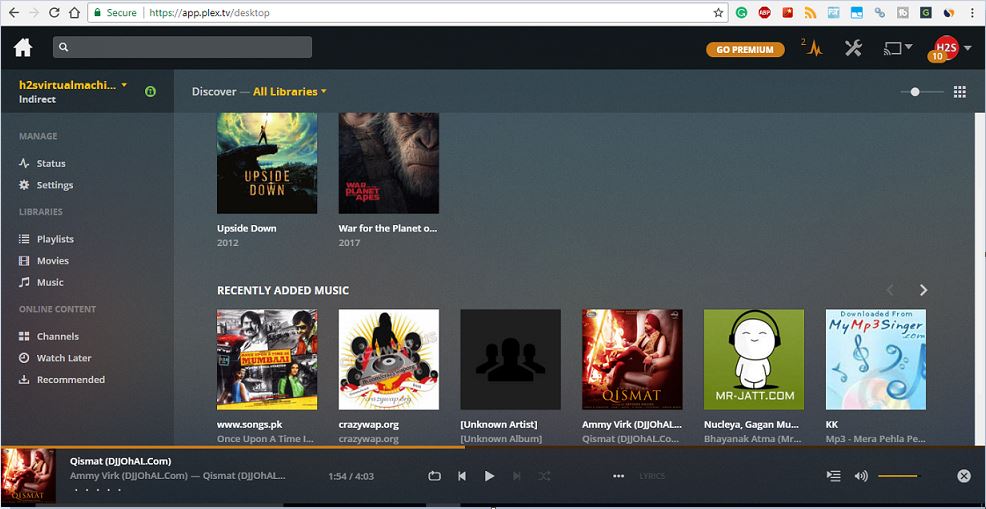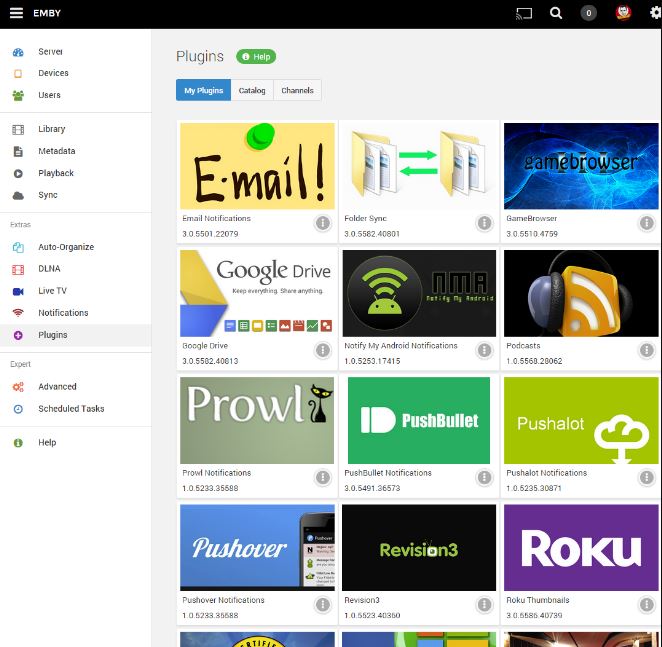We all are fond of music and videos and everybody has their own collection of media files both on computers and smartphones. But you can’t carry every time your huge collection of movies, songs, and other media files with you. In such a situation, the home media server comes in handy. There are a bunch of the best open-source and free media server software available online that can set up on your own personal home computer. You can store all your media files in one place on the media server and can access them remotely or locally using a computer or smartphone. For example, you are out of town and want to access your movies or music, what you will do, just take out your smartphone enter your home media server address, and boom!! Using media servers you can create your own personal YouTube, Netflix, and Vimeo. Some Media servers based on lightweight Linux, which means to save electricity and other resources you can install them on Rasberry Pi.
Best Free & Opensource Media server for Linux, Mac, or Windows
Here we have listed Free and Open source Media server software to be used in 2021 that can be work on both Linux and Windows.
PLEX Media Server (Freemium, not opensource)
We already have a done couple of articles on Plex and it really has some great features that allow it in our best media server list. The Plex Media Server is available for a variety of platforms such as Windows, Linux, Mac, Docker, and third-party NAS (network-attached storage device) Synology, Qnap, Netgear, Seagate, and more…
The Plex media server is not open-source instead of freemium software and offers some features on a subscription base only. However, still here because of its easy to use and install capabilities.
Whereas the Plex player comes under both freemium and open source license GPL v2. Due to its vast range of devices support the Plex continuously gaining popularity as a media streamer.

The Plex media server is based on a client-server model. It offers a wide range of client apps for different devices to support and stream its media server content easily. The Plex app is available for Android, Web, Windows, Kodi, Windows Phone, TiVo, SONOS, Android TV, Chrome cast, Amazon Fire TV, Apple TV, Amazon Alexa, Roku, Nvidia Shield, Xbox One, Xbox 360, PlayStation 3 & 4 and Smart TV.
Plex Media Server Features:
- Account management
- Support all format videos and audios
- iOS, Windows, and Android Mobile platform support
- Privacy and security
- Media Libraries Sharing
- No Storage Limit
- Online channels
- Live TV
- Plex cloud
- Mobile and Cloud Sync
- Parental control
- Audio Fingerprinting
- Remote Controls
- Media Optimizer and more…
If you are interested in PLEX, also see: How To setup Plex Media Server on Ubuntu Linux.
Kodi Open Source Home Theater Software
Kodi 100% Opensource Media center software that stores all your digital media files in one place like Plex and gives you a beautiful interface to access them. The Kodi was previously known as Xbox Media center or XMBC. Kodi provides a bit different media server software approach. It works more as a local media streamer rather than functions a server-client relationship like PLEX. It was developed as an XMBC open-source media center and still distributed under open source licenses. It plays content from two sources one is locally saved content and the second is via plugins.

It has a vast range of Addon for popular web services, applications, and scripts such as Pluto.TV, PS Vue, HDHomeRun, SoundCloud, Kodi Android Installer, Rooster Teeth, and more… It also provides an add-on to stream, video content from various sources like NBC, CBS, Funimation, and Crunchyroll. It is a perfect mixture of a media center PC/homer sever software. Kodi is also multi-platform support Media center/server software and supports Linux, macOS, Windows, Android, and embedded devices like the Raspberry Pi.
Kodi Features:
- TV Shows library supports
- Supporting all the main video formats
- Kodi can play all your music including mp3, flac, wav, and WMA formats
- Import pictures and view them in different styles such as slideshow
- Support Live TV recording
- JSON-RPC based remote interface
- Smartphone and Tablet Apps
- Add-Ons for popular web services, applications, and scripts.
- Works popular backends such as MediaPortal, MythTV, NextPVR, Tvheadend, and much more.
Emby Media Server
Emby is a great and best free Media server similar to Plex in features and user interface. While Plex is a closed source or freemium, Emby is totally open-source media server software. In comparison to Plex, the Emby is much easier to install for newbies and you can see our article: How to Install Emby media server, step by the step installation process. Emby offers lots of customization, media management, and database options.

The Emby Media server is available for Windows, Linux, Nas Devices, Mac OS, Docker, and FreeBSD. Like Plex, the Emby is also has a dedicated Linux installer for Debian, Ubuntu, Arch Linux, OpenSUSE, Fedora, and CentOS. If you are looking for a 100% open-source Media server for your office or home then Emby is the best one.
Web-based Management System of Emby to install plugins, edit metadata and subtitles, Sync, and more…

Emby also offers Apps for the mobile operating system: Emby Web client, Android, iOS, Windows 10, and Windows Mobile. Apart from the Emby Apps, it also has a good collection of TV Apps as follow:
- Android TV
- Amazon Fire Tv
- Shield Android TV
- Apple TV
- Chromecast
- Roku
- Emby Theatre HTML5
- Emby Theatre for Windows
- LG Smart TV
- Samsung Smart TV
- PS4
- Xbox One
- Windows Media Center
- Xbox 360
- Kodi
- PS3
Emby Media Server Features
- Emby Server automatically converts and streams the media
- Stream Live TV to any device
- Web-based tools to edit metadata and subtitles
- Easy DLNA
- Parental Controls
- Easily control content access
- Cloud Sync
- Chromecast
Jellyfin Media Server
Jellyfin is another popular open-source project that lets us create quickly a modern media server with an interactive web user interface to manage videos, images, and music from any device.
We can browser media content using Jellyfin on various devices such as computers, apps on your Roku, Android, iOS (including AirPlay), Android TV, or Fire TV device, or via your Chromecast or existing Kodi. Whereas when it comes to installing the Jellyfin server platform it doesn’t limit to Linux only, we can set it up on machines running Microsoft Windows, macOS, or in a Docker container.
Learn the process to install Jellyfin on Ubuntu 20.04/18.04 or Debian.

MediaPortal
MediaPortal is a well-featured open-source HTPC media center and similar to Kodi. It does not have features like Emby and Plex, but still, it’s very good open-source media server software. Using it you can watch, schedule, and record live TV like TiVo, streaming media, radio, and TV to any HTPC connected to your network., Check the weather, news, slideshow of pictures & videos, and more. It can access easily the web or mobile device. It also based on Client/Server Architecture.
See: How to Install and Configure the MediaPortal Media server on Windows 10 PC

Media Portal Features
- Watch TV, Videos, and DVD
- Watch Online Videos
- Listening to Music, Radio, and Web Streams
- Schedule Recordings
- Client/Server Architecture
- Skin System
- Plug-in System
- Check Weather Forecast
- Picture and video slideshow Viewer
- Multiple Tuner Support
- Time Shifting, Pause, and Record TV/Radio
- Read RSS Feeds
OpenFLIXR Media Server
OpenFLIXR 2 is the easiest free all-in-one home Media server that offers all media solutions in one package. OpenFLIX Media server software download, install updates of media programs automatically. This home media server is a combination of all well-known open-source projects out there including Plex Media Server.

Software used in OpenFLIXR are:
- CouchPotato + Radarr for Movies
- SickRage + Sonarr for automated TV show downloading
- Headphones- Automated music downloader
- Mopidy-Music Server
- Ubooquity-Comics and Ebooks & Web-based Reader
- Subtitles- AutoSub, Sub-Zero, Sickrage
- HTPC Manager
- Plex Media Server to organizes movies, series, music, and photos
- SABnzbd, NZBge, qBittorrent
- Netdata + Monit for monitoring
- Home-Assistant
- And More…
The OpenFLIXR media server needs a virtual machine to install since it is a virtual application.
OpenELEC
OpenELEC is a lightweight Linux operating system built to create a media server like Kodi. The full form of the OpenELEC is Open Embedded Linux Entertainment Center. Due to its lightweight, it can be easily installed on Raspberry, Apple TV, or low configurations systems.

Features of OpenELEC are:
- TV Show Management
- Movie Organizer and Player
- Music and Audiobook Player
- Freescale iMX6 ARM builds for Cubox-i, CuboxTV, and Hummingboard boxes
- TV and Personal Video Recorder
- Addon available to expand its feature
- Picture Browser
OSMC Media Center
OSMC Media center is last on our list. It is an open-source media center with a simple design and intuitive navigation system. The OSMC media center is based on Kodi and Debian. It also offers paid hardware kits and other accessories to enhance the OSMC user experience such as the Vero 4K. It is a hardware device with OSMC that supports 4K, HEVC, 10-bit content, and HD audio. It supports almost every type of media file. OSMC Media center is available for Linux, Windows, Mac OS, Rasberry Pi, Vero, and Apple TV.

A verdict on Best Free & Opensource Media Server Software Options
Although Plex, Emby, and Kodi are the best and most popular media servers. But that doesn’t mean that other media servers are not good some of them like OpenFlixr are worth trying. We have put everything we know on this list, now it’s all upon you which you want to use. If you want to install a media server along with a NAS server then you can go for open-source NAS software like FreeNAS.
You might also like to see:
- Free and Open-source Video Streaming Servers
- How to Setup a Media Streaming Server on Windows Without Any Software
- 6 Best Opensource Personal Cloud Software to Setup Cloud storage







Thanks, H2S Media Team!
Best Regards,
People can also looking for Ant Media Server
Thanx bro for this.
I like Kodi media server. Thanks
The PLEX media server is not open source.
I’ve tried them all! Everything mentioned here as well as others and I keep finding myself coming back to tada…
Windows! (Yuk.) But the reason is simple. Windows is “supported” by everyone. And when it comes to DVR capabilities (TiVo-like DVR stuff and not security cam junk), about the only OS to us is Windows. And believe me! I don’t like Microsoft! But if you want a HTPC, then start with Windows and learn whatever apps your hardware suggests you use. Because really, it’s all about the peripherals (like K/B, mouse, IR remote, etc.) and on that, I can’t recommend Logitech’s K400 highly enough.
Personally, I use VLC with for watching videos — it’s a little kludgy but a rock solid performer! And for streaming, nothing can beat the old fashioned web browser – nothing! So don’t go nuts with this HTPC “junk” especially when projects like KODI suddenly stop supporting streaming services like YouTube (which is really a YouTube problem that KODI won’t even attempt to fix) or when boxes like Roku don’t even have a web browser. It would be nice if Microsoft brought back their Media Center app for Windows 10 but with all the CODEC “royalties” it’s understandable why they won’t — Microsoft are a bunch of greedy little worms, but I digress. As long as you “have to” use Windows, you might as well lock it down (lest the underwear drawer sniffers be full snout up into your digital cracks), and use it along with the apps your stuff likes and maybe a few inexpensive peripherals like USB remote controls (which are surprisingly a dying breed).
Linux has VLC Media Player, web browsers, and drivers for Logitech peripherals. Not only are Linux distros free, but they can run on considerably less powerful hardware because they aren’t operating with the bloated carcass of 30 years worth of legacy WinNT code underneath. So you save money on the operating system as well as on the hardware, since a Rasberry Pi for under $100 can stream 4k video, run VLC, web browsers, etc. The network stack in Linux is far more reliable than Windows, which frequently struggles with things like multicast DNS and authentication in local workgroup networks, so you will almost certainly have a better experience with fewer problems. The misconception that Windows is somehow the “default”, or more ubiquitous than Linux is ironic, and only exists because of the very narrow portion of computing that is desktop PC’s. For a desktop PC, yes Windows is likely to be more familiar to more people. But for servers? As of May 2021 Linux makes up more than 75% of the public internet servers hosting most of the services and sites we all visit each day, including this website you’re reading this on. There is good reason for this, including the aforementioned stability of its network stack, the low program overhead that preserves system resources for the actual services and users, the low cost of ownership, the ease in which it can be maintained and automated, its near universal support for base hardware and devices, and the wide availability of high quality open source software. Then if you consider the rest of the computers that quietly facilitate nearly all aspects of our daily experiences–things like routers, point-of-sales, business phone systems, and the increasingly common devices and sensors making up the “Internet of Things”–all of these items are running some flavor of Linux, with the rare exception of those for which an entirely custom firmware has been developed (but even then custom firmware development frequently starts with Linux as a base image). That’s probably enough to prove Windows really represents a very small minority of devices, but there’s more! Smart phones, whether they are Android or Apple, run on operating systems that are modified Linux distributions! The same is true for MacOS/OSX, underneath Apple’s custom frontend sits an opensource core of Linux.
Windows is good for a few very specific applications–general purpose desktop personal computing, office workstations, and Active Directory corporate domain servers. Each of those could be handled using Linux, but then it really is the case where it’s more effort than it’s worth. But for things like media servers? You are wasting a ton of resources, both computational and financial, trying to use Windows in this case. Don’t be afraid of Linux, it doesn’t have to be complex or difficult, despite its reputation it can be very simple, and the fact that it’s currently being used to run our entire world of devices without most people even being aware of it is good evidence that it is exceptionally stable, reliable, and capable.
Great list! I’ve been looking for an open-source home media server and this article has given me some great options to consider. Thanks for sharing!